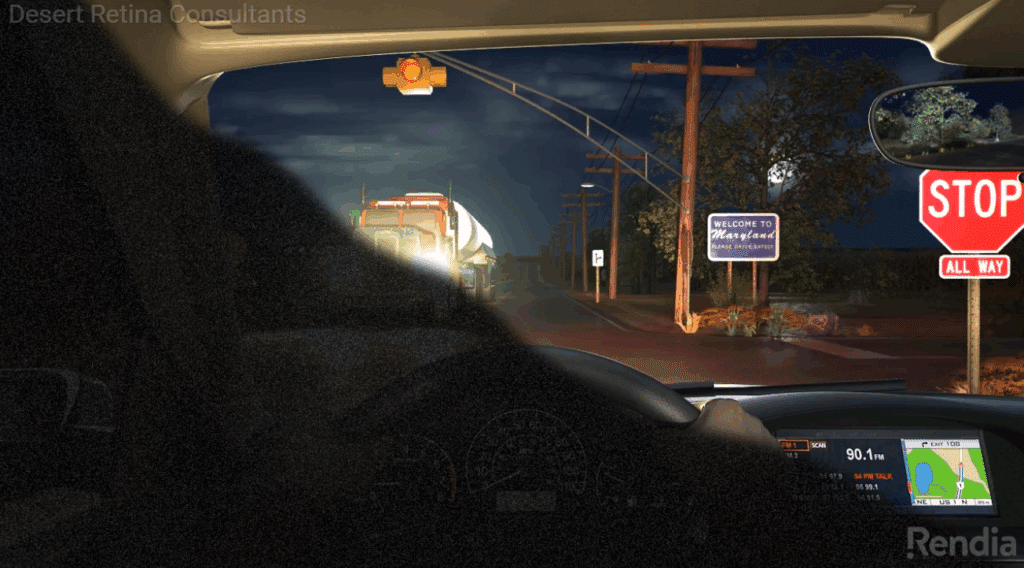Retinal Detachment: Symptoms & Causes
Posted on: August 18, 2025
Have you ever noticed sudden flashes of light, floaters, or a shadow creeping into your vision?
These could be warning signs of a serious eye emergency called retinal detachment—a condition that requires immediate medical attention to prevent permanent vision loss.
If you live in Palm Desert, Palm Springs, or nearby Coachella Valley communities, knowing the symptoms and causes of retinal detachment could make all the difference in protecting your sight. At Desert Retina Consultants, our fellowship-trained retina specialists have years of experience diagnosing and treating retinal conditions with advanced technology.
In this guide, we’ll explain everything you need to know about retinal detachment—what it is, the symptoms you shouldn’t ignore, common causes, and when to seek emergency care.
What is Retinal Detachment?
Your retina is a thin layer of light-sensitive tissue at the back of your eye that sends visual signals to your brain. Retinal detachment occurs when the retina pulls away from its normal position, disrupting its connection to the blood vessels that supply oxygen and nutrients. Without treatment, this condition can cause irreversible blindness.
According to the American Academy of Ophthalmology (AAO), retinal detachment affects approximately 1 in 10,000 people each year, but the risk increases significantly after age 50.
Why Immediate Treatment Matters
Retinal detachment is an eye emergency. The longer the retina remains detached, the higher the chance of permanent vision loss.
The prompt surgery within 24 hours of symptom onset often results in better visual recovery. Waiting too long can lead to irreversible damage, even if the retina is later reattached.
Residents of Palm Desert and Palm Springs have convenient access to Desert Retina Consultants, where urgent appointments are available for suspected retinal detachment.
Common Symptoms of Retinal Detachment
The symptoms can develop suddenly, and not everyone experiences them in the same order. Be alert for these warning signs:
- Sudden Onset of Floaters – Small specks, cobwebs, or dots drifting across your field of vision.
- Flashes of Light – Quick bursts or flickers, especially in your peripheral vision.
- Blurred or Distorted Vision – Straight lines may appear curved or bent.
- Shadow or Curtain Effect – A dark shadow may start in one area and spread across your vision.
- Loss of Peripheral Vision – Gradual narrowing of your visual field.

Main Causes of Retinal Detachment
While retinal detachment can happen without warning, several risk factors increase your chances:
- Aging (Posterior Vitreous Detachment) As we age, the gel-like substance inside the eye (vitreous) can shrink and pull away from the retina, causing tears that may lead to detachment. The AAO notes that this is the most common cause in adults over 60.
- Eye Injuries or Trauma Sports injuries, accidents, or any direct impact to the eye can cause retinal tears.
- Advanced Myopia (Nearsightedness) People with severe nearsightedness have longer eyeballs, which stretch and thin the retina, making it more vulnerable.
- Previous Eye Surgery Surgeries like cataract removal may slightly increase the risk, especially in those with other eye issues.
- Medical Conditions Diabetes and inflammatory eye diseases can damage the retina and increase detachment risk.
Who is Most at Risk?
You may have a higher risk of retinal detachment if you:
- Are over 50 years old
- Have had a previous retinal tear or detachment in the other eye
- Have a family history of retinal detachment
- Suffer from diabetic retinopathy
- Participate in high-impact sports without eye protection

How Retinal Detachment is Diagnosed
When you arrive for an exam, our retina specialists will:
- Review your medical and eye history
- Perform a dilated eye exam to see the retina clearly
- Use OCT imaging (Optical Coherence Tomography) for high-resolution scans
- Conduct ultrasound imaging if bleeding is present in the eye
Treatment Options for Retinal Detachment
If a retinal tear or detachment is detected, treatment will depend on the severity and location of the damage:
- Laser Photocoagulation – Uses laser light to seal retinal tears before detachment occurs.
- Cryotherapy (Freezing) – Seals tears by freezing the retina.
- Pneumatic Retinopexy – Injecting a gas bubble into the eye to push the retina back into place.
- Scleral Buckle Surgery – A silicone band is placed around the eye to gently press the retina into position.
- Vitrectomy – Removes vitreous gel and replaces it with a gas bubble or silicone oil.
Conclusion:
Retinal detachment is a serious eye emergency that can lead to permanent vision loss if left untreated. By recognizing the symptoms—such as sudden flashes, floaters, or a shadow in your vision—and seeking immediate care, you can greatly improve your chances of preserving your sight.
At Desert Retina Consultants, we’re proud to serve Palm Desert, Palm Springs, and the entire Coachella Valley with advanced diagnostic technology and expert surgical care. Our fellowship-trained retina specialists are here to provide the urgent attention you need when every second counts.
If you notice any warning signs of retinal detachment, don’t wait. Call us today at (760) 340-2394 or request an appointment online to protect your vision and your quality of life.
What our Retina patients says about us:
“Dr. Chan has been my Retina specialist for many years now. I see him for treatment every two or three months and he is without a doubt a doctor who cares very much for his patients. I feel that I’m in the best hands and always receive the best possible care.”







